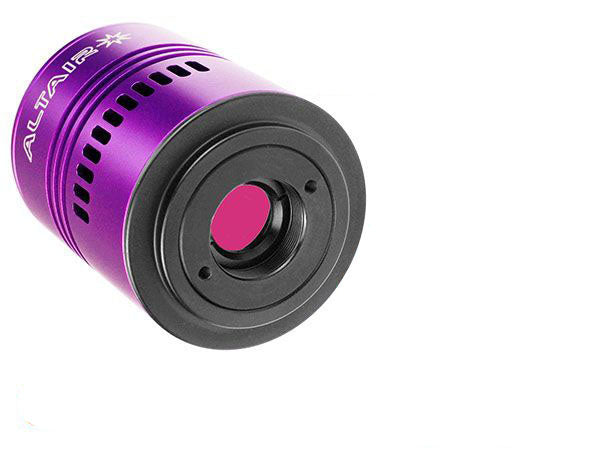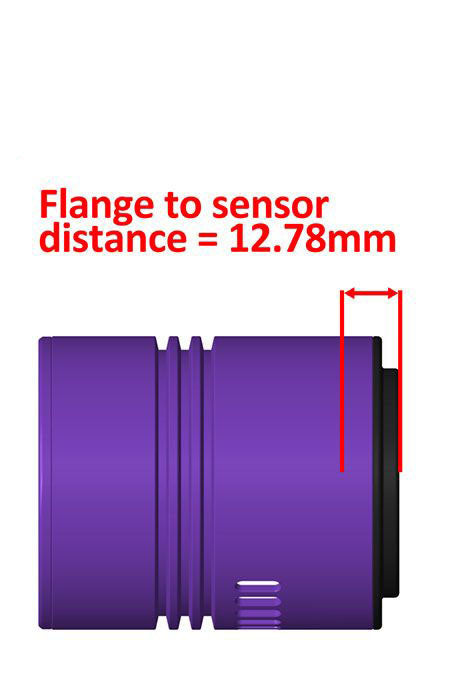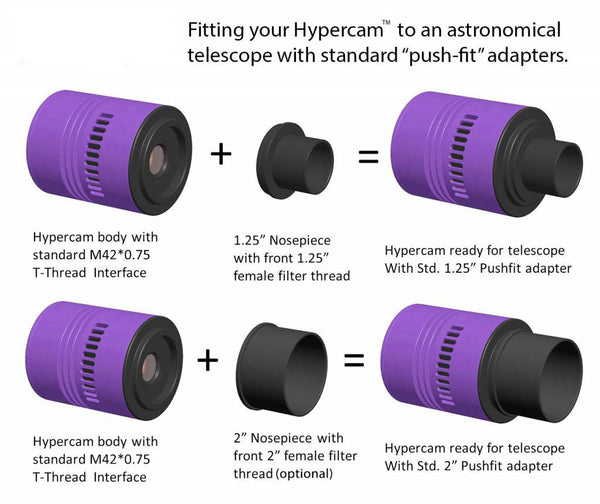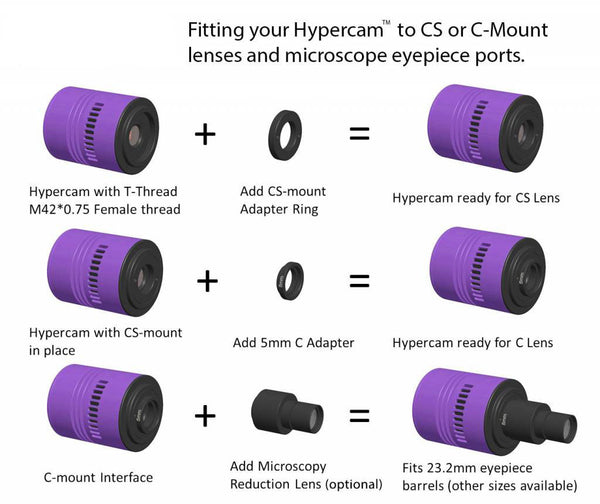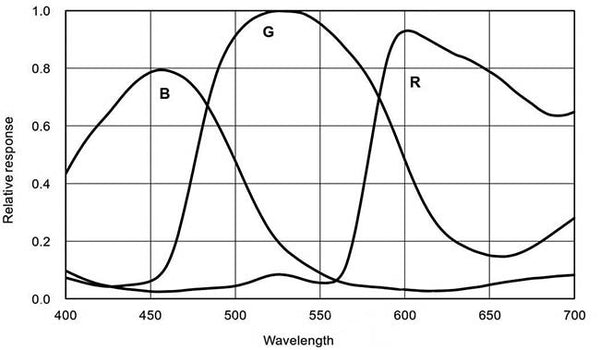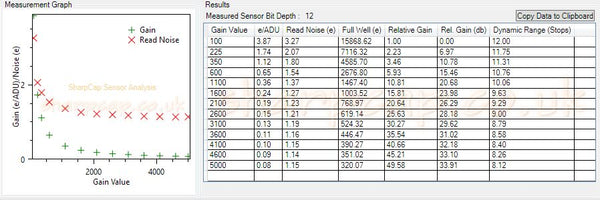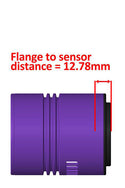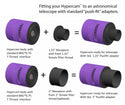The Hypercam 183C Colour camera is the thinkers' alternative to a DSLR camera when it comes to astro-imaging.
It has a 20mp Sony IMX183 sensor, featuring amp glow reduction and high sensitivity for extremely smooth, detailed images.
The IMX183 is one of the most sensitive Back Side Illuminated BSI sensors available, with incredibly low read noise.
Version 2 has the following additional features:
- 4GB DDR3 RAM Memory Buffer for better performance with mini-PCs
- Temperature sensor, with data available in realtime.
- ROI (Region of Interest) for cropped higher speed solar, lunar and planetary imaging.
- 4K Mode (cropped).
SPECIAL OFFER! FREE 1 YEAR SharpCap PRO License! Includes ultra-accurate polar alignment assist, deepsky CMOS exposure time optimisation assist, live stacking for EAA/Video astronomy, live darkframe and flat frame subtration.
Click here for more SC PRO features. Just download the latest SharpCap, connect your camera, register when the screen pops up and sign up for your free license. Download SharpCap 3.0+ now to take advantage of this special offer.
Easier than a DSLR and no "astro modding" required: Hypercam is much easier to use and focus than a DSLR, thanks to the live preview mode in AltairCapture and SharpCap software. You can see a tiny star clearly in real-time, because there is no video compression. Unlike a DSLR, there's no need to modify your camera to capture detail in red hydrogen wavelengths, because it has no red blocking filter in the way. There are no clumsy power connectors, no mirror to lock up, and a "true" RAW mode output. You get what this Sony sensor sees.
Low read noise. The Sony IMX183 CMOS sensor has very low read noise, wide dynamic range, and high sensitivity. The IMX183 ExmorR rated Back Illuminated Sensor has high-sensitivty, low dark current, no smear, and excellent anti-blooming charateristics. BSI technology moves the sensor circuitry behind the pixel, so unlike conventional sensors the light path is not blocked, resulting in higher quantum efficiency than a CCD sensor.
Try deep-sky "lucky" imaging. Short exposures stacked take advantage of high resolution sensors with low read noise, reducing atmospheric aberrations and tracking errors or wind vibration. The more frames you stack, the smoother the image becomes, and the higher the dymanic range. Long cumulative exposure times of many hours can be achieved with modest equipment. The result is a smoother, sharper image, while suppressing any residual amp glow.
Great for refractors. With a pixel size of 2.4um, and an active imaging area of 13 x 9mm, the Hypercam IMX183C is best suited for imaging at F7 or faster speeds, and performs extremely well an Altair refractor, and say an 0.8sx focal reducer.
Video Astronomy/EAA Friendly. The Hypercam IMX183 sensor is not only desirable for Deepsky Imaging - it's also great for Video Astronomy or "EAA" Electronically Assisted Astronomy. All thanks to the 20mp resolution, high sensitivity, and amp glow reduction technology. What's more you can use the Live Stacking features in the AltairCapture software or SharpCap PRO. Time-lapse all-sky imaging or video is easy with a DSLR lens and optional Hypercam Lens Adapters (product code: CLA-EOS or CLA-NIKON).
To sum it up, the most desirable features of the Hypercam IMX183 camera are:
- 20mp resolution SONY Exmor R Back Side Illuminated IMX183 CMOS sensor
- 5440 x 3648 active pixels in a 13x9mm 16mm diagonal array (16.05mm x 12.61mm physical sensor size).
- Extremely low read noise enabling deepsky lucky imaging and very smooth image quality.
- Amp glow reduction technology onboard reduces amp glow, reduces noise, and increases contrast.
- High Dynamic Range with 12 bit ADC to 16bit output .FITS files in RAW mode, for beautiful deepsky images.
- Up to 17.5 Frames per second video in full 20mp resolution. (You will need a computer with high USB bandwidth to achieve these speeds, preferably with Intel or Via hardware USB controller on the motherboard).
Pure RAW mode and "digital" RGB output modes for better post processing: The Hypercam sensor ADC can 12bit RAW files, which are stretched to 16 bit. In RAW mode analog (on-sensor) gain is used for ultra low read-noise images. Because the output is completely "RAW" in analog mode, there is no partial "downstream digitial" processing like with a DSLR or other cheaper Chinese cameras of similar design, resulting in true RAW mode for the best deepsky performance. True RAW mode allows greater flexibility and consistency in processing large stacks of frames for deepsky "lucky" imaging, where the camera's low read noise can be taken advantage of. Either .FITS image or .SER video files are captured in their purest form for later processing in your software of choice. Of course for Video Astronomy / EAA use, you can select RGB Mode and capture .AVI files, or just view the screen with full access to white balance, gamma, contrast and histogram controls, just like any other camera.
USB3.0 speed and USB2.0 reliability: USB3.0 and on-board memory buffering give much faster transfer speeds than USB2.0 cameras, however, if like most imagers, you prefer to use longer and more flexible USB2.0 cables for better tracking and reliability with a USB2.0 hub, no problem! The Hypercam is completely compatible with USB2.0 protocol. Just install the software, and off you go!
QUALITY software and drivers included:
AltairCapture: Unlike cheaper cameras, Altair Astro has spent considerable time improving the extensively featured and intuitive AltairCapture software, which can be downloaded from cameras.altairastro.com. AltairCapture is a stable 64 bit Windows application, which allows full control of the camera in high speed video or still mode. It includes extensive automation features, and supports all the major file formats useful for astro imaging and professional scientific imaging in 16bit, 12bit or 8bit mode. Furthermore, the popular PHD Guiding, SharpCap and Firecapture are also natively supported. ASCOM drivers are also available for download at cameras.altairastro.com where you can also get regular driver updates. The installation process is very simple, and unlike with cheaper cameras, there is no need to waste time tweaking .DLL files to make your camera perform as expected.
SharpCap PRO: Altair Astro have worked closely with SharpCap developer Robin Glover since 2015, to fully integrate Altair cameras with SharpCap at a basic level. Now, Sharpcap PRO enables even more features with this camera, such as software driven polar alignment (more accurate than any other method), live flat frame subtraction and live darkframe subtraction. The fast, accurate polar alignment feature in SharpCap PRO is a life-saver for imaging, minimising setup time.
Wide operating system and USB compatibility: Although the Hypercam is a USB3.0 camera, it is also fully compatible with USB2.0 ports when a longer cable and less speed are required, for example in deepsky or video astronomy using the live stacking features in AltairCapture or Sharpcap. Windows 7 to Windows 10 software is widely supported by AltairCapture in 64bit mode (see technical info for details).
Fan cooling: The Hypercam is cooled with and internal low vibration fan. The fan can be switched on or off and the speed controlled in AltairCapture and SharpCap. Cool air is drawn in through the vents at the side of the casing, over a large internal heat-sink. The heat-sink is connected directly with the sensor board just like a computer CPU. The free flow of air through the casing cools not only the sensor, but all the internal electronics boards. Cooling is especially desirable for long exposure imaging to reduce thermal noise. Some camera casings get uncomfortably hot during a solar imaging session, and the sensor can reach around 60 or even 70 degrees. This can cause the electronics to become glitchy and unreliable. The Hypercam is designed for consistent, reliable solar imaging with a solar filter and diagonal or Altair Solar Wedge. With the fan running, the Hypercam casing will always remain cool.
Support & warranty: Altair delivers proper on-shore English-speaking UK/EU support with a 2 year manufacturer warranty against defects in materials and workmanship. New users should visit Altair Camera Google User Group where you can get answers to technical questions. The group is also a great place to share tips and techniques, to get the best out of your camera. The AltairCapture software interface supports most European languages including English, German, French, Indonesian, Japanese, Korean, Polish, Russian, Chinese, Spanish, Thai, and Turkish.
File formats: The camera can be fully controlled in AltairCapture and SharpCap to output uncompressed .AVI and .SER video files for solar system imaging, as well as all common still image formats such as .JPEG .PNG .TIFF .BMP, and .FITS (for deepsky imaging) to mention just a few. The Hypercam supports 8bit or 12bit output. The 12 bit output mode can be used for deep sky imaging with less frames needing to be stacked and a wider pixel intensity range. The sensor is extremely sensitive and a good candidate for video astronomy, especially with small refractors. Find out more about bit depth here. Find out more about video & file formats here.
The Hypercam platform: The Hypercam platform supports “Trigger Mode” to make long exposures of over 5 seconds easier to control. With most cameras, in normal video mode, you have to wait for an exposure to complete before the camera will accept, say a command to abort the frame, for say clouds, aircraft, or an alignment issue, like kicking the tripod and so-on, changes in gain, exposure time, or re-aligning or refocusing. For long exposures, normal video mode is inconvenient, especially for video astronomy and deep-sky imaging, however in Trigger Mode, you can stop the camera instantly (even if you are half way through a long exposure) change the settings, and re-start the camera. The Hypercam also has an improved on-board frame buffer to improve data transfer stability at high frame rates (to reduce dropped frames) and to increase compatibility with a wider range of PCs. The improved buffers give a more consistent data transfer rate over USB2.0 and USB3.0 buses on laptops and desktop PCs.
Included in the box:
Camera body with internal cooling fan, heat-sink, and front female M42x0.75mm T-Thread interface (12.5mm backfocus).
1.8m High-speed USB3.0 cable.
2" OD Nosepiece with standard 2" M48x0.75mm filter thread on the front. (code ALTAIRH-2IN).
Built-in UV-IR Blocking Filter, AR coatings. (Removable for sensor cleaning).
Plastic screw-on dust cap.
Allen key for removing the C-Thread insert.
Note: This camera does not come with software in the box. To operate the camera you will need to download the latest camera drivers at cameras.altairastro.com (opens new window)
Sensor & performance specifications:
ALTAIRH183C: SONY Exmor R BSI IMX183 Color CMOS sensor
Sensor Size: 1" diagonal (15.86mm)
Exposure duration shortest/longest: 0.264 ms (0.000264 secs) / 5 secs (Video Mode)
0.264 ms (0.000264 secs) / 1000 secs (Trigger Mode)
Bit depth: 8bit & 12bit mode switchable
Pixel size microns: 2.4 x 2.4 um
Resolution in pixels: 5440x3648
Recording System: Still Picture and Video
Region of Interest (ROI) support: Unavailable
Approx. Max frame rates (assuming computer Bus operating at full bandwidth)*:
8bit mode:
5440x3648 17.5FPS
2736x1824 50FPS
1824x1216 60FPS
12bit mode:
Approx. 60% ~98% of above
* Based on average user reports. May be revised as we get more data. The shorter the exposure duration, the faster the frame rate. An expensive PC does not guarantee a fast frame rate because PC bus and main board architecture vary.
Sensor QE / Quantum Efficiency: approx. 84%
Readout: Progressive Scan
Shutter: Electronic Rolling Shutter
Software & OS support:
Drivers & AltairCapture software download (Windows only): cameras.altairastro.com (opens new window).
Driver support: PHD2, AltairCapture, SharpCap
AltairCapture OS support: Win XP 32bit / Vista/ 7/ 8/ 10 (32 & 64 bit)
NOTE: Windows 10 is recommended for best performance, with 2013 or later USB host controller v1.0 or later.
SharpCap (a 3rd party application) is also fully supported and tested with native drivers.
USB Port & Cable: 3.0 USB Cable, 1.8m cable (USB2.0 also supported at low frame rates).
ST4 Port & Cable: Standard ST4 Opto-Isolated, 1.5m cable, iOptron, Celestron, Skywatcher SynScan GOTO.
Camera Format:
Cooling: High Performance Electronic Fan-cooling System with Heat-sink connected to sensor via cold-finger
Camera body length: 80 mm
Weight grams: 320 g (camera net weight)
Optical window can be removed:
Mono Camera: AR-coated clear optical window 350-1050nm wavelength transmission
Colour Camera: AR-coated UV/IR blocking filter 400-700nm wavelength Transmission
Back-focus & Adapter compatibility:
Optical Window is removable for cleaning.
Camera body: OD 65mm
Camera body thread: M42x0.75 T2 Thread to CS -Mount insert allows direct attachment of CS-Mount lens (or C-Mount lens with optional 5mm extension).
C-mount lens adapter 5mm extension: Optional
C-mount lens compatibility: C-Mount male threaded lens with 12.5mm back-focus (or flange-distance) requirement.
CS-mount lens compatibility: C-Mount male threaded lens with 12.5mm back-focus (or flange-distance) requirement.
Astro filter thread adapter: Included, 1.25" OD and 2” OD (optional), Female thread
Sensor surface distance from flat end of CS-mount adapter: 12.5 mm
Sensor surface distance from flat end of 1.25" / M42 Astro adapter: 37 mm
Operating environment conditions:
Power consumption: 0.905 W (standby);
1.68 W (running with Fan off);
2.525 (running with Fan on);
Max operating temp: 50 °C
Lowest operating temp: -10 °C
Max operating humidity: 80 % RH
Power source in Volts: 5V DC (via USB cable)
Windows PC Hardware Requirements:
Minimum CPU: Equal to Intel Core2 2.8GHz or Higher
Minimum Memory: 2GB or More
USB port: USB2.0 High-speed Port or USB3.0 High-speed Port
Monitor Display: 17" or Larger
Software delivery: Downloaded online and saved to hard drive.
Packaging:
Protective silicon rubber end-cap for camera CS-thread.
Plastic end cap for 1.25" nosepiece.
Padded cardboard storage box with durable foam inserts
Optional Accessories:
Clear AR coated optical window;
Software delivery: Downloaded online at cameras.altairastro.com and saved to hard drive.
Quick Start & AltairCapture instructions: Downloaded online at cameras.altairastro.com and saved to hard drive.
Warranty: 2 years manufacturer warranty against defects in materials and workmanship. Return to point of purchase.

